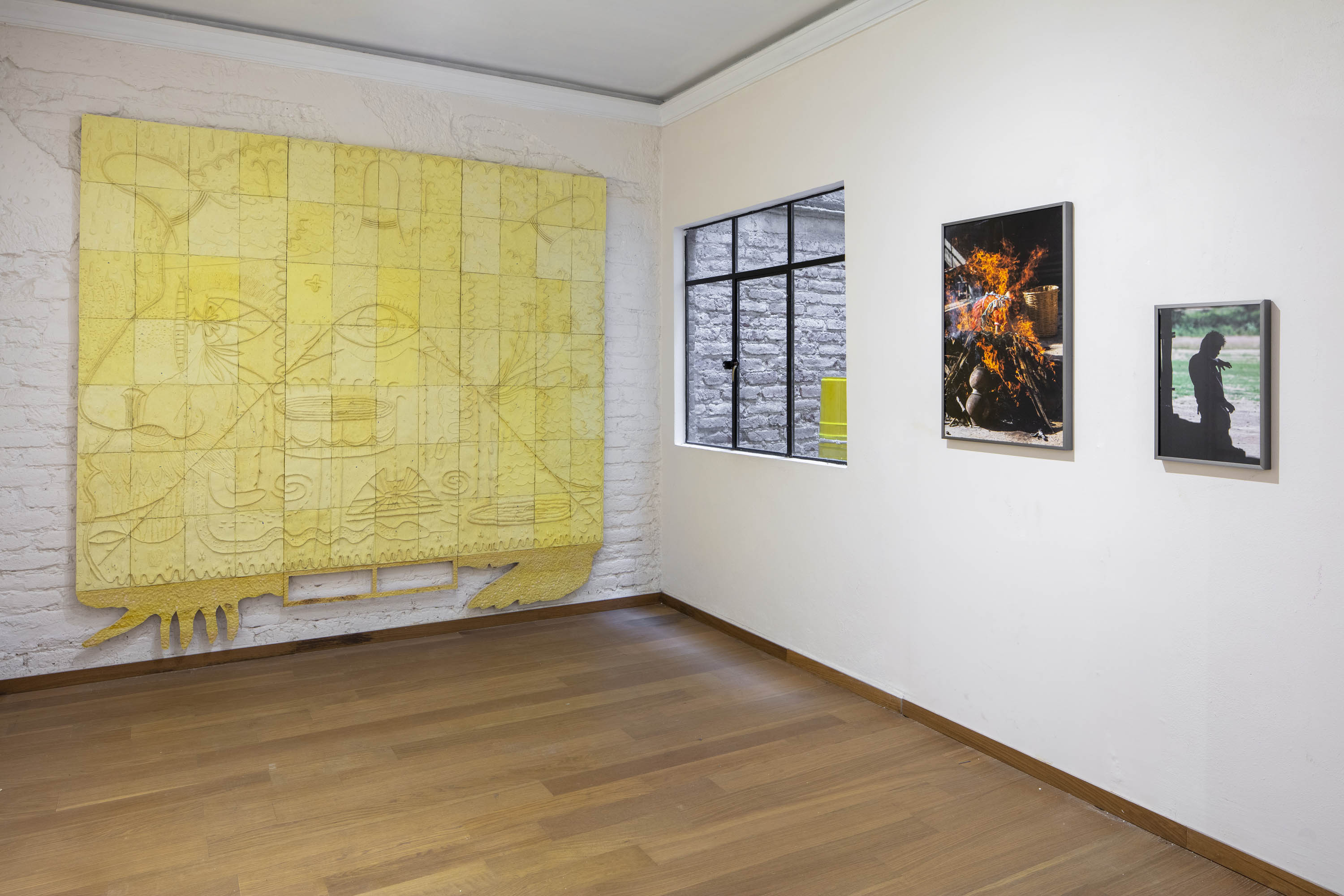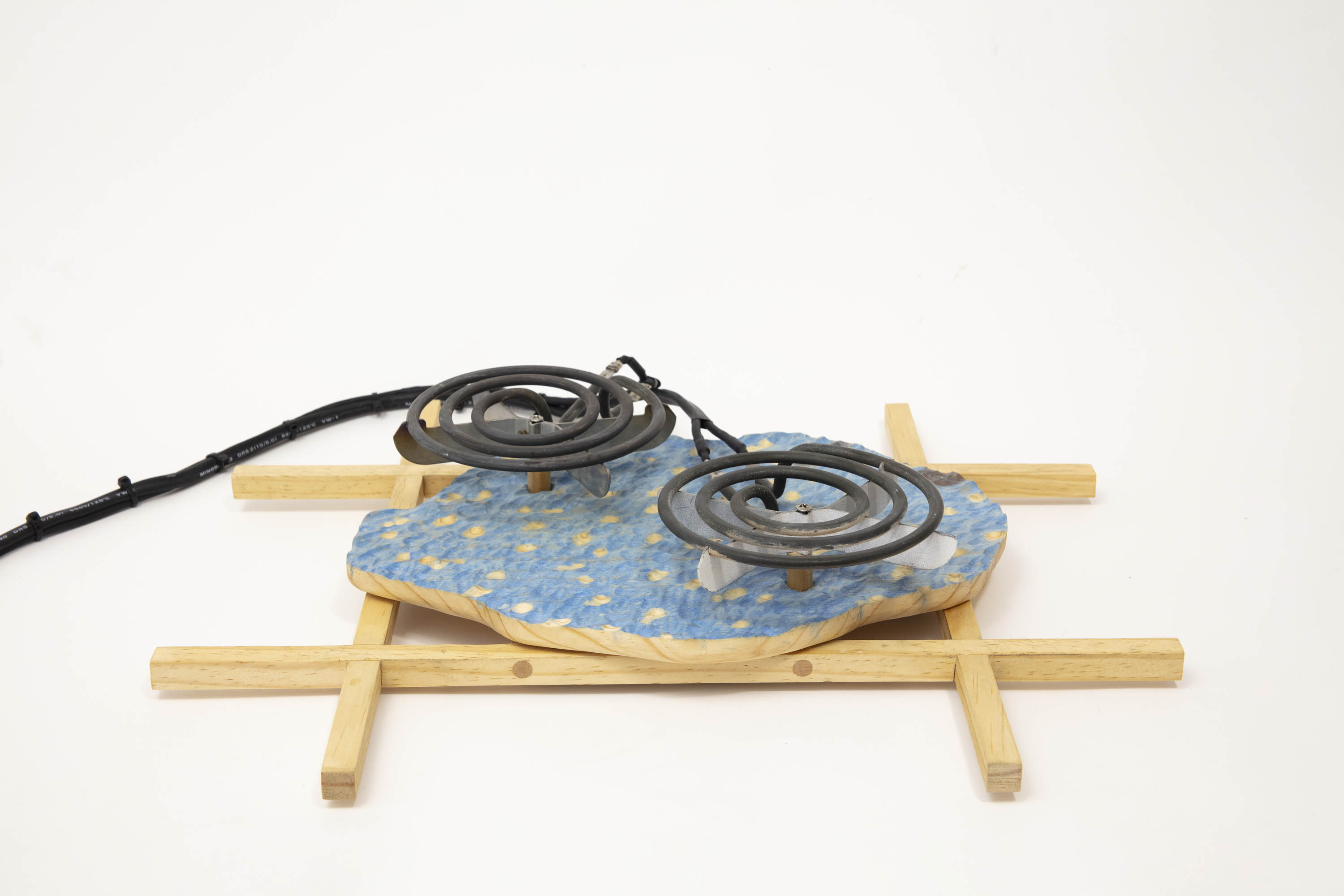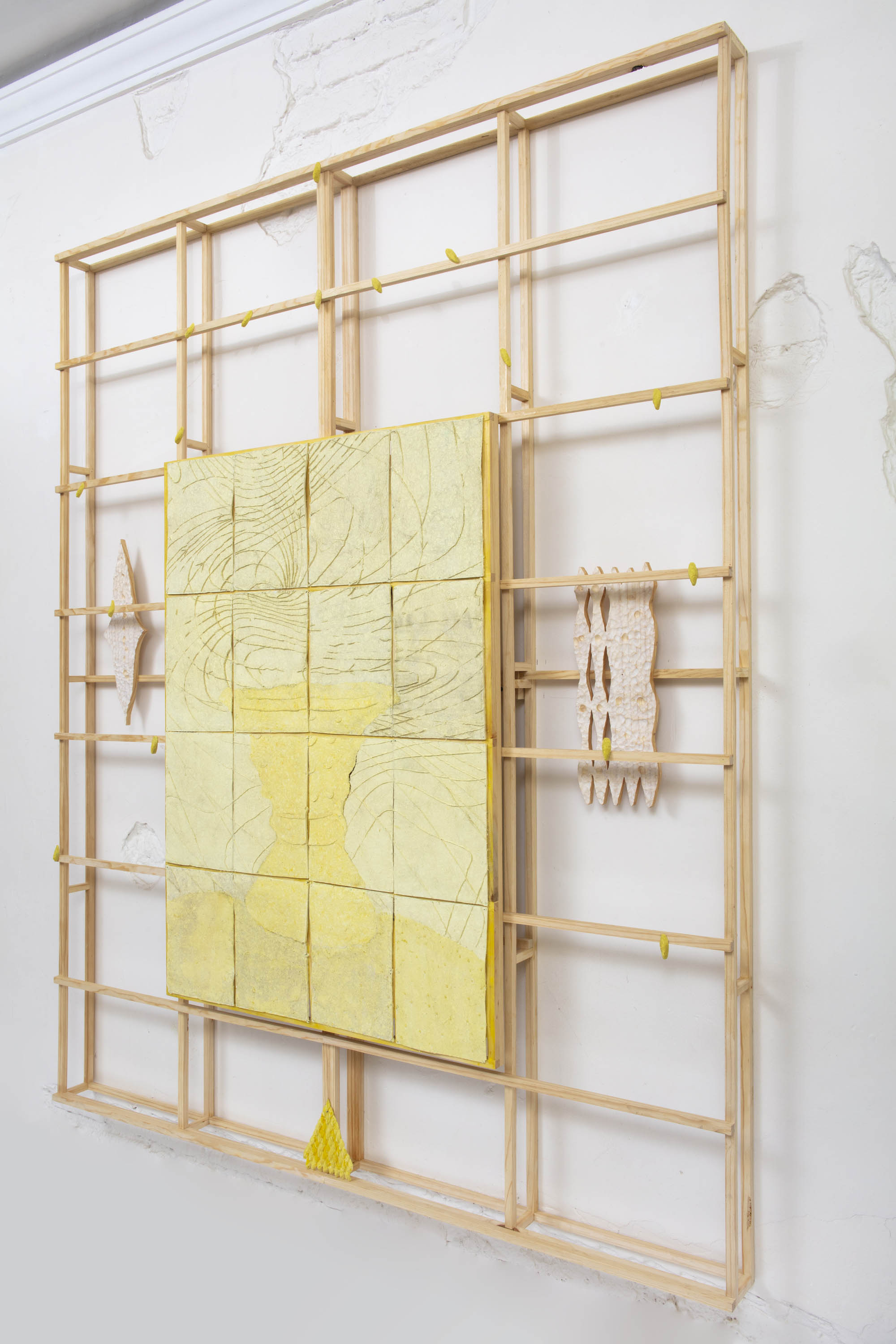la calle, la casa, la cocina
Galería Agustina Ferreyra
Ciudad de México, México
2024





The Street, The House, The Kitchen, explores the interdependence between public and private
life; the exterior and the interior and certain ideas around this relation, present in the work of
the artists and evident in these three symbolic and physical spaces that are recurrent in their
practice. These spaces become fundamental pillars of life in the city; The Street, as the
epitome of public space and bastion of identity; The House, as a paradigm of private life and a
reflection of the vast and complex web of socio-affective relations, and lastly The Kitchen, as a
symbol of sustenance and a laboratory of experimentation.
The works here presented by Ulrik are the result of artisanal and rudimentary processes of making and cooking, that López Medel transforms into sculptures and drawings, two of the more predominant mediums of his practice. The house becomes a studio, and the kitchen a laboratory where paper is chopped, blended and cooked in order to become a story; a chair, an endemic snake; or where wood turns into charcoal that later will be used to draw. The processes through which these materials are submitted to, and their formal results, comment on the use and programming of the same space in which they are presented, returning the symbolic meaning to the kitchen, food and matter as synonyms and analogies of sustenance, reunion and vitality.
The works here presented by Ulrik are the result of artisanal and rudimentary processes of making and cooking, that López Medel transforms into sculptures and drawings, two of the more predominant mediums of his practice. The house becomes a studio, and the kitchen a laboratory where paper is chopped, blended and cooked in order to become a story; a chair, an endemic snake; or where wood turns into charcoal that later will be used to draw. The processes through which these materials are submitted to, and their formal results, comment on the use and programming of the same space in which they are presented, returning the symbolic meaning to the kitchen, food and matter as synonyms and analogies of sustenance, reunion and vitality.







Along these lines, the galvanized metal alludes the everyday
landscape of the street and the city; a roof, a temporary wall, or the wheeled artifact of a street
vendor. The street enters the house and immediately pins us to a social landscape.
The street as a social space, is the realm in which collective experiences are materialized. It is a territory in constant definition, a forced date with otherness. In it, the public face of our private lives become visible and so do the personalities and spirits an of our cities and neighborhoods, the rhythm with which they cover us when we transit them, and the symbolic and social spaces considered epitomes of the public.
Just like the street, the photography of Dorian Ulises López Macías (México, 1980) could be understood as an archive in constant expansion, that for over a decade has been gathering the history of the real Mexico- the one that is alive, through portraits and vignettes of the everyday life of its inhabitants.
Taken over the course of ten years, and produced as part of the Mexicano series, the works here presented explore brown identity and celebrate the quotidian beauty of everyday Mexico found throughout the country.
The street as a social space, is the realm in which collective experiences are materialized. It is a territory in constant definition, a forced date with otherness. In it, the public face of our private lives become visible and so do the personalities and spirits an of our cities and neighborhoods, the rhythm with which they cover us when we transit them, and the symbolic and social spaces considered epitomes of the public.
Just like the street, the photography of Dorian Ulises López Macías (México, 1980) could be understood as an archive in constant expansion, that for over a decade has been gathering the history of the real Mexico- the one that is alive, through portraits and vignettes of the everyday life of its inhabitants.
Taken over the course of ten years, and produced as part of the Mexicano series, the works here presented explore brown identity and celebrate the quotidian beauty of everyday Mexico found throughout the country.
It is through the almost obsessive exercise of traveling, knowing
and exploring Mexico, the Mexico that speaks and exists on the streets, that López Macías
manages to capture existence in resistance; bodies that live outside the canon, dissident
beauties, and identities that unmask complex realities, and become political vehicles of alterity
that allow us to dive in profound and private intimacies. For López Macías, the street is also a
political subject and what happens in it, its history.







Smoke filterEmbossing of galvanized sheets, galvanized pipe, galvanized iron, pine wood and alcohol ink on galvanized sheet.
126 x 224 x 13 cm
2024
Embossing of galvanized sheets, galvanized pipe, galvanized iron, pine wood and alcohol ink on galvanized sheet.
49 5/8” x 88 3/16” x 5 1/8” in
2024
Filtro de humo
Repujado de láminas galvanizadas, tubo galvanizado, hierro galvanizado, madera de pino y tinta de alcohol sobre lámina galvanizada.126 x 224 x 13 cm
2024



Yellow Bed and Sun
Galvanized sheet embossing, alcohol ink on galvanized sheet, pine plywood and magnets.
21.6 x 30.3 x 1.7 cm
2024
Galvanized sheet embossing, alcohol ink on galvanized sheet, pine plywood and magnets.
8 1/2” x 11 15/16” x 11/16” in
2024
Cama y Sol amarillo
Repujado de lámina galvanizada, tinta de alcohol sobre lámina galvanizada, triplay de pino e imanes.21.6 x 30.3 x 1.7 cm
2024







On a quenepa tree
Paper mache
2024
24 x 24 x 16 cm
2024
Paper mache
9 7/16” x 9 7/16” x 6 5/16” in
2024En un palo de quenepa
Papel maché24 x 24 x 16 cm
2024
La calle, La casa, La cocina, explora la interdependencia entre lo público y lo privado; el
exterior y lo interior y las reflexiones en torno a dicha relación, presentes en la obra de los
artistas y estos tres espacios físicos y simbólicos que comparten a través de su obra. Éstos se
presentan como pilares fundamentales de la vida en la ciudad; La Calle como espacio público y
bastión de identidad, La Casa como paradigma del espacio privado y reflejo de entramados
socioafectivos, y por último La Cocina como símbolo de sostén y laboratorio de
experimentación.
Las obras aquí presentadas por Ulrik, son el resultado de procesos rudimentarios y artesanales de
elaboración y cocción, que López transforma en esculturas y dibujos, dos de los medios
predominantes en su práctica. La casa se convierte entonces en un estudio, y la cocina en un
laboratorio/taller en donde se tritura y se cocina el papel, que se transforma en una silla, o en
donde se quema la madera que servirá de carboncillo para dibujar. Los procesos a los que
éstos materiales son sometidos, y sus resultados formales, comentan sobre el uso y
programación del espacio mismo en el que se generaron, regresándole el significado a la
cocina, la comida, y la materia, como sinónimos y analogías de sostén, reunión y vitalidad.
Sobre estas líneas, el acero galvanizado hace alusión a un paisaje cotidiano y callejero; es un
techo, el muro temporal en una construcción, o el artefacto rodante de un camotero. La calle
entra a la casa, y nos ubica en un paisaje social.
La calle como espacio social, es el ámbito en donde se plasma y se materializan las experiencias
colectivas. Es un territorio en constante definición, la cita forzada con la otredad. En ella se
refleja la cara pública de nuestras vidas privadas, y se hacen visibles las personalidades de los
barrios y ciudades - el ritmo con el que éstos nos arropan cuando las transitamos, y los
espacios simbólicos y sociales considerados epítome de lo público.
Al igual que la calle, la fotografía de Dorian Ulises López Macías (México, 1980) podría
entenderse como un archivo fotográfico en constante expansión que desde hace más de una
década documenta la historia del México real y vivo, a través de retratos y estampas de la vida
cotidiana de sus habitantes. Tomadas en el transcurso de diez años, y producidas dentro de la
serie titulada Mexicano, las obras aquí presentadas exploran la identidad marrón y celebran la
belleza cotidiana encontrada en el paisaje callejero del país.
Es a través del ejercicio casi obsesivo de viajar, recorrer y conocer el México que habla y existe
en la calle, que López Macías logra capturar en caras, estampas y viñetas, una existencia en
constante resistencia; cuerpos que resisten el canon, bellezas disidentes, e identidades que
desenmascaran realidades complejas, a la vez que se transforman en vehículos políticos de
alteridad que nos adentran en intimidades profundas, caseras, privadas. Para López Macías, la
calle es también sujeto político, y lo que en ella sucede, historia.




Serpent chair#2
Paper mache on pine structure.
63 x 89 x 4.5 cm
2024
Paper mache on pine structure.
24 13/16” x 35 1/16” x 1 3/4” in
2024
Silla serpiente #2
Papel maché sobre estructura de pino.63 x 89 x 4.5 cm
2024

Slow burn
Metal cans, gas grill, gas tank and various wood.
Latas de metal, parrilla de gas, tanque de gas y diversas maderas.
2024
Metal cans, gas grill, gas tank and various wood.
17 ¾” x 12 ⅝” x 57 ⅞” in
2024
Quema lenta
45 x 32 x 147 cmLatas de metal, parrilla de gas, tanque de gas y diversas maderas.
2024



Serpent stool
Paper mache on pine structure.
63 x 89 x 4.5 cm
2024
Paper mache on pine structure.
24 13/16” x 35 1/16” x 1 3/4” in
2024
Banco serpiente
Papel maché sobre estructura de pino.63 x 89 x 4.5 cm
2024



VasePaper mache, flowers and leaves.
40 x 40 x 43 cm
2024
Paper mache, flowers and leaves.
15 3/4” x 15 3/4“ x 16 15/16“ in
2024
Florero
Papel maché, flores y hojas.40 x 40 x 43 cm
2024




(..)(・.)(: )(¨)( :)(.・)(..)
Charcoal iron, galvanized sheet, cork, pine wood, alcohol dye on pine wood, electric burners and water.
50 x41 x 49 cm
2024
Charcoal iron, galvanized sheet, cork, pine wood, alcohol dye on pine wood, electric burners and water.
19 11/16” x 16 1/8” x 19 5/16” in
2024
(..)(・.)(: )(¨)( :)(.・)(..)
Hierro al carbón, lámina de galvanizado, corcho, madera de pino, tinte de alcohol sobre madera de pino, hornillas eléctricas y agua.50 x41 x 49 cm
2024







Cheirous veil
Paper mache and pine wood on pine structure.
205 x 165 x 13 cm
2024
Paper mache and pine wood on pine structure.
80 11/16” x 64 15/16” x 5 1/8” in
2024
Velo cheiroso
Papel maché y madera de pino sobre estructura de pino.205 x 165 x 13 cm
2024





My own Sun
Paper mache pulp, dried squashes, pastel,pine wood and acrylic paint.
218 x 252 x 72 cm
2022
Paper mache pulp, dried squashes, pastel,pine wood and acrylic paint.
86” x 99” x 26” inches
2022
Mi propio Sol
Pulpa de papel maché, guajes, madera de pino y pintura acrílica.218 x 252 x 72 cm
2022